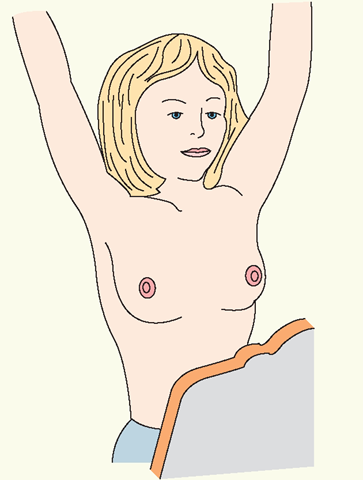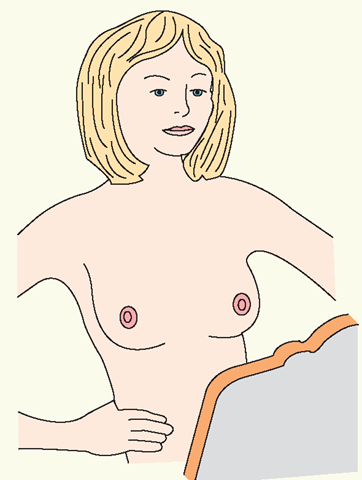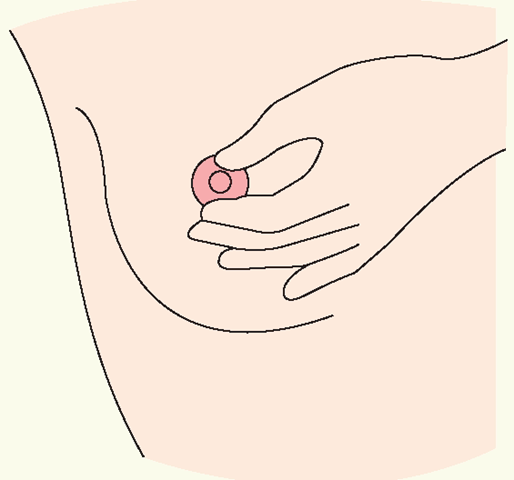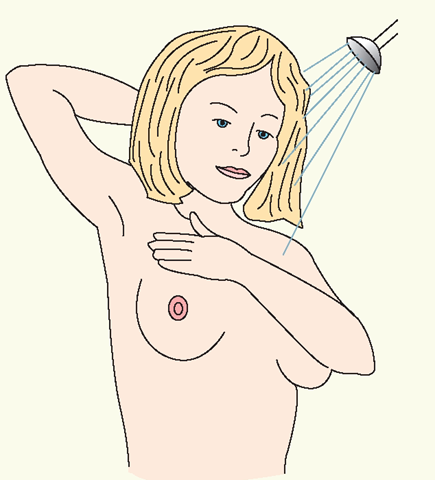COMMON SURGICAL TREATMENTS
Some diagnostic surgical procedures mentioned previously also may be used for treatment. These procedures include laparoscopy, culdoscopy, colposcopy, and biopsy of the cervix, uterine lining, or breasts.
Dilation and Curettage
Dilation and curettage (D&C) is the most frequently performed gynecologic surgery. It can be used to diagnose disorders and to treat some disorders. In D&C, the cervix is dilated (widened) using calibrated rods. A spoon-shaped instrument (curette) is then passed into the uterus, and the endometrial lining is scraped out (curettage). D&C takes approximately 15 minutes; it is often done in a day-surgery department on an outpatient basis.
Purposes
A D&C is used as a diagnostic procedure in women with abnormal vaginal bleeding or to obtain tissue for examination after a positive Pap test. The uterine scrapings are examined for evidence of malignant or nonmalignant growths or other abnormalities. Sometimes, a D&C is done just before the menstrual period in an effort to find the cause of female infertility. D&C is frequently used to evaluate endometrial hypoplasia (incomplete development of the uterine lining), menorrhagia (excessive menstrual flow), and metrorrhagia (bleeding between menses). In some cases, the D&C is all that is needed to eliminate the problem.
A D&C is used as treatment in other instances. It may be used after an abortion, whether spontaneous or therapeutic, to remove the retained products of conception. A D&C is always performed after an incomplete abortion.
Nursing Considerations
Preoperative preparation is similar to that for any person about to receive anesthesia. In many cases, general anesthesia is used.
The client usually makes an uneventful postoperative recovery. She will need to wear a perineal pad and receive perineal care. A mild analgesic, such as acetaminophen (Tylenol) or ibuprofen (Advil), usually relieves minor discomforts.
In rare instances, the vagina is packed with gauze at the time of the surgery, which may make voiding difficult. The pack is usually removed the next day. Carefully monitor the client to make sure that she can void and that she does not experience urinary retention.
Because the D&C is often done on an outpatient basis, teaching is vital. Vaginal discharge will be bloody at first, but should quickly become serosanguineous. This drainage typically does not last more than a few days. Teach the client signs of abdominal distention and how to perform perineal care. Instruct the client to call the healthcare provider if any problems occur. Carefully document all teaching.
Hysterectomy and Pelvic Exenteration
A hysterectomy is the surgical removal of the uterus. It may be performed for a variety of reasons: cancer of the cervix, ovaries, or uterus or to treat uterine fibroids, severe endometriosis, or a prolapsed (“fallen”) uterus. In some cases, such as a ruptured uterus during labor, an emergency hysterectomy must be performed. The uterus may be removed by means of a vaginal hysterectomy (through the vagina) or an abdominal hysterectomy (through an abdominal incision).
In some cases of advanced malignancy, especially if the client is young, a pelvic exenteration is performed, in which the entire contents of the pelvis are removed. This complex procedure has a high mortality rate. After surgery, the client will have urine and feces draining through openings (ostomies) on the abdominal wall.
Cosmetic Breast Surgery
Corrective surgery may be performed on healthy breasts. A plastic surgery revision of the breast is referred to as a mammoplasty. If the breast is to be made larger, the term augmentation mammoplasty is used; if the breast is to be made smaller, the appropriate term is reduction mammo-plasty.
Following breast surgery, reconstructive mammoplasty is often done. Usually, these operations are not serious and cause no adverse effects. Occasionally, however, the woman’s body rejects materials implanted during the augmentation mammo-plasty, and the materials must be removed. Because of concerns for safety, implants must be used cautiously with follow-up monitoring.
Mastectomy
Mastectomy is surgical removal of a breast. It is discussed in the section on breast cancer later in this topic.
NCLEX Alert NCLEX clinical scenarios can present inpatient or outpatient situations in which knowledge of the female reproductive system is prevalent. Options for these clinical scenarios can include observational skills regarding post procedure recovery pre- or postprocedure teaching, and communication skills for the client and her family.
NURSING PROCESS
DATA COLLECTION
Carefully observe the woman with a reproductive disorder. The information obtained from the physical examination and data collection forms a baseline that is used for future comparison and determines the presence of suspected disorders and complications. Report any changes in the baseline level (see In Practice: Data Gathering in Nursing 91-1).
Many clients are reluctant to discuss sexual or reproductive concerns. One nursing goal is to express concern and to put the client at ease when discussing sexuality or sexually related concerns. In addition, observe the client’s emotional response to the disorder or disease. Does the client need assistance to meet daily needs? Is the disorder life threatening? Does the disorder affect social activities, sexual identity, or self-esteem? Is the client anxious or fearful of the outcome?
Special Considerations :CULTURE & ETHNICITY
When the client is from a culture with which the nurse is unfamiliar, attempt to gather sufficient data about how cultural differences may affect care. For example, in some cultures the woman must pass information through her husband, who will then convey it to the nurse. In some cultures, all decisions are made by family consensus or by the assigned matriarch (e.g., grandmother, elder aunt, or mother). The woman may need to consult the patriarch or male decision-maker for the family. In some cases, decisions are made with the good of the society or the family as the highest goal, and the desires of the individual are less important. Any intervention that does not consider such cultural norms will be ineffective.
PLANNING AND IMPLEMENTING
Together with the client, family, and other members of the healthcare team, plan for effective individualized care to meet the client’s needs. Provide preoperative and postoperative care for the client undergoing procedures such as hysterectomy and mastectomy. The client with a reproductive disorder also may require teaching about preventive measures, such as breast self-examination. The client may need assistance in meeting needs, dealing with emotional problems,and understanding more about the disorder, its prognosis, and treatment.
IN PRACTICE: DATA GATHERING IN NURSING 91-1
FEMALE REPRODUCTIVE SYSTEM
• Sexual history
• Reproductive history (pregnancies, abortions)
• Method of birth control used
• Menstrual history; date of last menstrual period
• History of sexually transmitted infections (STIs) and other gynecologic infections
• Visual observation of external genitalia
• Breast examination; teaching of breast self-examination
Teaching Feminine Hygiene
Nurses are in an excellent position to teach clients about personal hygiene. Many women do not realize that after urinating or defecating they should wipe from front to back to prevent urinary tract and vaginal infections. Caution the woman who is susceptible to infections against using bubble baths, bath oils, and nylon panties or pantyhose. Also stress the importance of thorough handwashing and perineal care, especially during menses. Menstrual discharge is an excellent culture medium for microorganisms. Techniques to prevent vaginal infections are presented in In Practice: Educating the Client 91-1.
Teach the client the procedure for breast self-examination and reaffirm the necessity of a yearly Pap test, breast examination, and serology tests for sexually transmitted infections (STIs). Stress the need for adequate nutrition, including vitamin D and calcium intake, as well as fruits and vegetables. Teach the client about the dangers of smoking
IN PRACTICE EDUCATING THE CLIENT 91-1
PREVENTION OF VAGINAL INFECTIONS
• Wipe from front to back after going to the bathroom.
• Wash hands thoroughly after using the bathroom or changing perineal pads.
• Change tampons or sanitary pads frequently Dispose of them safely Place them in sealed plastic bags in the trash or burn them, if possible.
• Pull panties, with perineal pad attached, straight down to avoid spreading infection during menses.
• Remove a tampon immediately and call a healthcare provider if fever, nausea, vomiting, diarrhea, weakness (signs of toxic shock syndrome) appear. Do not use deodorant tampons.
• Do not use vaginal deodorant sprays or scented powders.
• Douche only when absolutely necessary. Use the cleanest technique possible. Dispose of all equipment each time in a safe way.
• Clean the bathtub carefully before use or take showers.
• Do not use bubble bath or bath oil, especially if susceptible to infection.
• Do not use colored or scented toilet tissue.
• Wear only cotton panties, ventilated pantyhose, or hose with garters; avoid nylon panties.
• Avoid tight pants or jeans, nonventilated clothes, or tight exercise clothing.
• Change out of a wet bathing suit immediately after swimming. Stay out of swimming pools or hot tubs if you are susceptible to infection. (The chlorine in the pool may predispose to infection. An infected person also can spread the infection to others.)
• Cut down on intake of sugar
• Have the male partner wear a condom when having sexual intercourse. A water-soluble lubricant, such as K-Y jelly may be needed to increase comfort and prevent irritation.
• Check with a healthcare provider at the earliest sign of pain or infection. (Sexual partner should be checked also.)
• Consult healthcare provider regarding use of oral contraceptives or other hormones..
Teaching Breast Self-Examination
Most professionals recommend that each woman examine her breasts monthly, approximately 1 week following menses, to check for any lumps, nodules, or thickening. If the woman is postmenopausal, she should examine her breasts on the same date each month. The key is to note any change from the previous month.
Self-examination of the breasts is done in several steps using the flat of the fingers, rather than the fingertips (see In Practice: Educating the Client 91-2).
Key Concept Women discover approximately 40% of all breast cancers by self-examination. A woman who has had a mastectomy should check her chest wall and the scar area because these sites are common areas for recurrence.
Providing Perineal Care
Give perineal care to women after any perineal surgery. Many women need instruction in this procedure.
Providing Sitz Baths
Sitz baths are frequently ordered for a female client following a vaginal hysterectomy or delivery.Remember to clean equipment after each use and to inform the client why the procedure is necessary (whether it is done to cleanse the area, to aid in the healing process, or to make the client more comfortable).
Performing a Douche or Vaginal Irrigation
The douche or vaginal irrigation is prescribed less frequently than in the past. Frequent douching is believed to irritate the vaginal mucosa and predispose the client to infection. The secretions from the mucous membrane protect the area from infection. Therefore, it is not desirable to wash away these secretions unless necessary.
If a vaginal irrigation is ordered, explain the procedure and purpose to the client. Vaginal irrigation cleanses the vaginal canal of excess discharge, supplies heat or medication, and relieves pain and inflammation.
The healthcare provider orders the solution to use. Common solutions include povidone-iodine (Betadine), saline solution, sterile water, or a solution of acetic acid (vinegar in water). Disposable douches also are available (see In Practice: Nursing Procedure 91-1).
Inserting a Vaginal Suppository
Medication is applied to the vaginal canal by means of vaginal suppositories. Most suppositories must be kept refrigerated until ready for use.
EVALUATION
Evaluate outcomes of care with the client, family, and other members of the healthcare team. Have short-term goals been met? For example, is the client ready for discharge following a hysterectomy? Are long-term goals still realistic? Does the woman need follow-up care or education? Is long-term therapy required; for example, radiation therapy or chemotherapy for cancer? Planning for further nursing care takes into consideration the client’s prognosis, any complications, and the client’s response to care given.
DISORDERS RELATED TO THE MENSTRUAL CYCLE
Amenorrhea
Amenorrhea is the absence or abnormal stoppage of menses (menstruation). If an adolescent female has not begun to menstruate by her 15th year, she should be examined. The difficulty may be hormonal, requiring a specialist’s attention. Amenorrhea also may be caused by nutritional or emotional factors or by malformations of the female organs. (Menses are normally absent in pregnancy and after menopause.) Treatment is prescribed based on the cause of the client’s amenorrhea.
Nursing Alert Women who are starving often experience amenorrhea, a serious symptom, which is one sign of anorexia or bulimia. Women in intensive athletic training also may experience amenorrhea. They should be under the supervision of an experienced sports medicine specialist.
Menorrhagia
Menorrhagia is excessive bleeding in amount or duration during menstruation. The excessive blood loss results in anemia. If this irregularity occurs in a young girl, it may adjust itself. However, monitoring is necessary. If it occurs during menopause, it may indicate pathology. Menorrhagia also may occur in the client using an intrauterine device (IUD) for birth control. In excessive bleeding unexplained by organic causes, hormone therapy may be helpful. A D&C also may be performed as therapeutic treatment.
Metrorrhagia
Metrorrhagia is bleeding between menstrual periods. It is abnormal and should be brought to a healthcare provider’s attention because it may indicate cancer or retained placental tissue in the postpartum woman or in the woman who has had a spontaneous or induced abortion. Metrorrhagia may indicate fibroid tumors and is frequently associated with the use of oral contraceptives; in this instance, it is referred to as breakthrough bleeding.
Dysmenorrhea
Dysmenorrhea is painful menstruation. Normal menstruation is not painful. Functional causes of menstrual pain may stem from constipation, insufficient exercise, poor posture, fatigue, or improper placement of a tampon. These conditions are easily remedied. Very severe pain may be owing to an increase in prostaglandin secretion, which intensifies uterine contractions. Medications, such as ibuprofen (Motrin) or mefenamic acid (Ponstel), effectively block prostaglandin production. Dysmenorrhea often fades by itself after childbearing, but occasionally can be a symptom of a displaced uterus, tumor, endocrine disturbances, or endometriosis.
IN PRACTICE :EDUCATING THE CLIENT 91-2
BREAST SELF-EXAMINATION
Instruct the client to perform the following self-examination monthly.
Before a Mirror
1. Inspect the breasts with your arms at the sides.
2. Raise your hands above the head. Breast movement should be free and equal on both sides. Look for changes in the contour of each breast (discharge, puckering, dimpling, or scaling of the skin).
3. Press your hands firmly on the hips and bow slightly toward the mirror pulling your shoulders and elbows forward. Note any changes in breast contours.
4. Squeeze the nipple of each breast gently between the thumb and index finger. Report any discharge (clear or bloody) to the healthcare provider immediately
In the Shower
1. Keeping your fingers flat, move them gently over each part of the breast. Use the right hand to examine the left breast, and the left hand to examine the right breast. Check for any lump, hard knot, or thickening.
2. Check the axillae for any unusual signs (rash, lesions, lumps, absence of hair, unusual pigmentation).
EDUCATING THE CLIENT 91-2 continued
Lying Down
1. To examine the right breast, put a pillow or folded towel under the right shoulder
2. Place your right hand behind the head. With your left hand, fingers flat, press gently in small circular motions around an imaginary clock face. Begin at outermost top of left breast for 12 o’clock. Move to 1 o’clock and so on, all the way around, back to 12 o’clock. (A ridge of firm tissue in the lower curve of each breast is normal.)
3. Move in an inch toward the nipple and keep circling to examine every part of the breast, including the collar bone and breast bone. Vary your pattern of checking between the circular pattern and a vertical pattern.
4. Repeat the above steps for the left breast.
5. If you find any abnormalities, measure the distance and direction from the nipple, and report to the healthcare provider.
Extreme Irregularity
Extreme irregularity of menses should be evaluated because it may indicate a hormonal deficiency that could result in later sterility.




![tmp325139_thumb[2] tmp325139_thumb[2]](http://what-when-how.com/wp-content/uploads/2012/08/tmp325139_thumb2_thumb.png)
![tmp325140_thumb[2] tmp325140_thumb[2]](http://what-when-how.com/wp-content/uploads/2012/08/tmp325140_thumb2_thumb.png)
